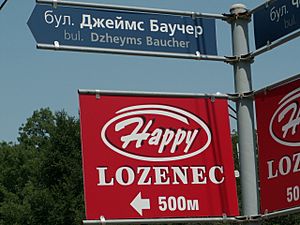Romanization of Bulgarian facts for kids
The Streamlined System for the Romanization of Bulgarian is a special way to write Bulgarian words using the Latin alphabet (like the one English uses). It helps people who don't know the Cyrillic alphabet (which Bulgarian uses) to read and understand Bulgarian names and words. This system was created by Lyubomir Ivanov in 1995 at the Bulgarian Academy of Sciences.
Here's how some Bulgarian letters are changed into Latin letters:
| А A |
Б B |
В V |
Г G |
Д D |
Е E |
Ж ZH |
З Z |
И I |
Й Y |
| К K |
Л L |
М M |
Н N |
О O |
П P |
Р R |
С S |
Т T |
У U |
| Ф F |
Х H |
Ц TS |
Ч CH |
Ш SH |
Щ SHT |
Ъ A |
Ь Y |
Ю YU |
Я YA |
Contents
How the System Started and Is Used
Mapping Bulgarian Names in Antarctica
This system first helped map Bulgarian geographical names in Antarctica. Imagine naming mountains and glaciers! The Antarctic Place-names Commission of Bulgaria officially adopted it on March 2, 2005.
Official Use in Bulgaria
Later, the Bulgarian Government chose this system for official use. This means you'll see it everywhere! It's on your identity documents, like passports. It's also on road signs and street names. Official websites and databases use it too. This system became a part of Bulgarian law in 2009. This law is called the Transliteration Law.
Global Recognition
The United Nations (UN) adopted the Streamlined System in 2012. Then, in 2013, the US and UK also started using it officially. This shows how important and widely accepted this system has become. Some people even suggest using this approach for other Cyrillic alphabet languages, like Russian.
Key Ideas Behind the System
The Streamlined System was designed with a few main goals in mind. These goals help make sure the system works well for everyone.
- Sounding Right in English: The main goal is to make Bulgarian words sound as close as possible to how they would sound in English. This helps English speakers read them, even if they don't know Bulgarian.
- Getting Back the Original Letters: The system also tries to make it possible to figure out the original Bulgarian (Cyrillic) spelling. This is important for accuracy.
- Looking Natural in English: Transliterated words should look natural in English. They shouldn't seem too strange or "un-English."
- Simple and Easy to Use: The system is designed to be straightforward and easy to understand. It keeps things simple.
Special Rules and Exceptions
There are a couple of special rules:
- Original Latin Spellings: If a name is not Bulgarian and already has a common Latin spelling, that spelling is kept. For example, James Bourchier is used, not Dzheyms Baucher.
- Word Endings: The ending -ИЯ is written as IA, not IYA. This change was made in 2006.
Example of Transliteration
Here's an example of how the system works. It shows a sentence in Bulgarian (Cyrillic) and then how it looks using the Streamlined System.
- Example (Article 1 of the Universal Declaration of Human Rights):
| Всички хора се раждат свободни и равни по достойнство и права. Те са надарени |
Vsichki hora se razhdat svobodni i ravni po dostoynstvo i prava. Te sa nadareni |
Comparing with Other Systems
The Streamlined System is designed to work well for English speakers. This is because English is a very common language around the world. Other Cyrillic alphabet languages, like Russian and Ukrainian, also have systems that focus on English.
The Streamlined System is quite similar to an older system used by the US and UK until 2013. However, there are some small differences in how certain letters are changed. For example, the Bulgarian letter Х is written as H in the Streamlined System, but as KH in the older system.


